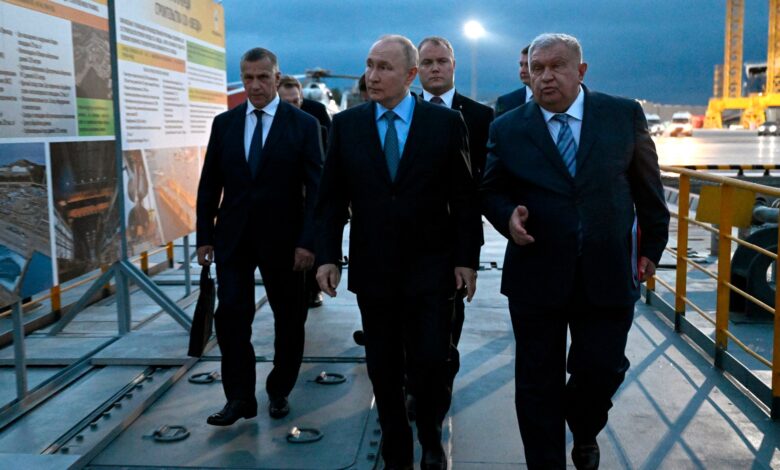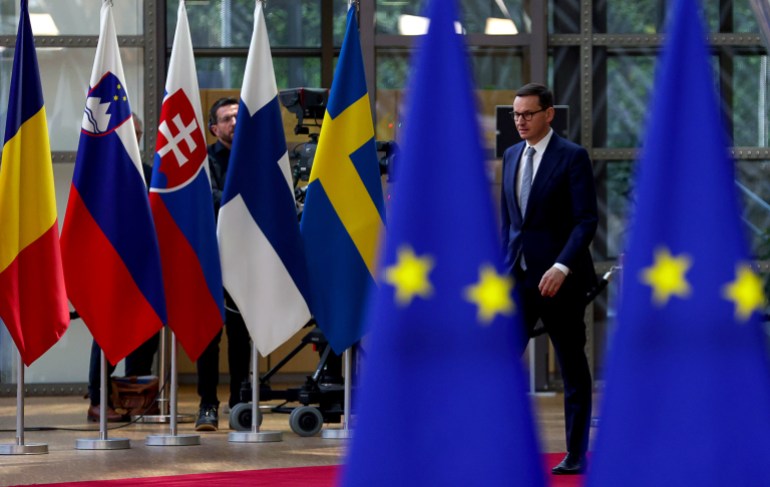Sanctions on Russian oil have failed. Were they ever meant to succeed?

Last December, the European Union banned imports of Russian crude oil in a bid to starve the Russian war machine into submission over its invasion of Ukraine.
A year later, the ban appears to have been a failure.
The Kyiv School of Economics (KSE), which monitors Russian oil sales, estimates that Moscow will make $178bn from oil sales this year, rising to a potential $200bn next year.
These amounts are lower than the record $218 bn Russia earned in oil revenues during the first year of the war, when Europe was still buying about half its oil exports, but they show that Russia has replaced that lost revenue remarkably quickly.
“Russia now has to ship its oil over much larger distances. You basically have only China and India left, so it reduces competition and reduces prices,” said Jan Stockbruegger, a researcher with the Ocean Infrastructure Research Group at the University of Copenhagen.
But not by much. The KSE says Russia’s benchmark Urals crude traded at $84 a barrel in October, not too far below the $90.78 average price commanded by Brent crude in the same month.
Sanction-proof tankers
Anticipating this, the EU, along with the G7, last year placed a $60-per-barrel price cap on Russian oil sold to third parties. This was an ambitious and unprecedented bid by the EU to enforce its will beyond its borders when most Russian oil was still being shipped by Western-owned and Western-insured tankers.
But Russian entities have since bought much of the ageing portion of the fleet from Western companies at prices attractively higher than scrap metal, cobbling together a shadow fleet outside Western control.
A shadow tanker is “usually a tanker that does not have Western or G7 involvement, in terms of ownership, insurance, finance or any other services”, Stockbruegger told Al Jazeera. “It’s basically a sanction-proof tanker.”
Western protection-and-indemnity-insured tankers dropped two-thirds of their trade in Russian crude between April and October, trading places with a shadow fleet that tripled that trade to 2.6 million barrels a day over the same period.
The KSE estimates there are at least 187 shadow tankers carrying Russian crude and refined petroleum products.
Ukraine’s Western allies could still reduce Russia’s oil revenue by a quarter if they did more to enforce the embargo and price cap, and by more than half if they lowered the price cap to $50 a barrel, says the KSE.
But Moscow is banking that they will not.
On November 27, Russian President Vladimir Putin signed off on a 70 percent increase in defence and security spending for next year, to $157.5bn. The entire Russian budget of $412bn is itself 13 percent higher than last year, based on higher expected earnings from oil.
Economist Maria Demertzis, a senior fellow at the Bruegel think tank in Brussels, told Al Jazeera a price cap was always going to be difficult to enforce.
“How do you prevent a country in the Gulf [from] buying and selling energy to third countries? It’s very difficult to monitor,” she said.
Political will was an added obstacle.
“At the beginning of the invasion, 50 percent of the world in population terms either sided with Russia or were neutral,” Demertzis said.
“This was an indication that countries were not prepared to cut their economic ties to Russia, and therefore any help that the [EU or] G7 would need to try to enforce sanctions just wasn’t there,” she told Al Jazeera.

‘Token’ measures
There are signs that the EU and the G7 are getting more serious about enforcing the price cap.
In October, Washington may have single-handedly shaved $3 off the price of Russian crude by sanctioning two tankers for using US-based services – the price cap’s first enforcement.
Last month, Washington slapped sanctions on three more Liberian-flagged tankers after discovering they regularly shipped Sokol crude from Russia’s far east to Indian Oil Corp.
The EU reportedly floated measures last month to allow Denmark to inspect and block Russian oil tankers travelling through the Danish straits – a chokepoint that ships leaving Russian Baltic ports must pass to reach the Atlantic.
Stockbruegger believes such gestures will remain token, however.
“The simple reality is we need Russian oil on the market,” he told Al Jazeera.
“If it is cut out, oil prices globally will rise and inflation will skyrocket. [Joe] Biden will not win the [2024] election if the price of gasoline in the US rises significantly. So the sanctions are set up to ensure Russian oil reaches global markets,” he said.
Figures from the Institute of International Finance (IIF) last month show that China, India and Turkey have massively increased Russian crude imports during the Ukraine war, and could be transshipping crude or refined products to Western markets.
The use of go-betweens has been documented elsewhere in sanctions evasion. Robin Brooks, the IIF chief economist, also demonstrated that German carmakers had increased their exports of vehicles and spare parts 55-fold to Kyrgyzstan, sevenfold to Kazakhstan and fourfold to Armenia over two years.
“This export surge started after Russia invaded Ukraine, so it’s obvious this stuff is going to Moscow. This has to stop,” Brooks wrote on X, formerly Twitter.
Can renewables fill the gap?
There is one way in which Moscow’s sales to Europe are genuinely falling, and irreversibly.
In the first 10 months of this year, wind and solar power generated a record 28 percent of Europe’s electricity, a six-point increase on last year’s performance, according to Ember, a London-based think tank. They have long overtaken natural gas and coal in electricity generation, for which consumption fell by 15 percent and 30 percent, respectively, this year.
“It remains profoundly cheaper to produce electricity by solar or wind [power] rather than fossil fuels or nuclear [power]. That is why they are taking market share,” Beatrice Petrovich, a senior energy and climate analyst at Ember, told Al Jazeera.
This is good news for a continent that paid between $1 trillion and $2 trillion more for its energy imports during the first year of the Ukraine war than it did in 2021.
“Europe is better prepared than last winter,” Petrovich said. “This is the best insurance policy against price hikes and volatility.”
It is also good news for Europe’s goal to cut greenhouse gas emissions by 55 percent in 2030, relative to 1990.
But it does not cut Russia’s revenue.
“If India and China don’t see the argument that we are trying to make … this is very worrying,” said Demertzis. “The centre of gravity now has gone east, and if they feel one way about things, they have the power to pursue it.”
“We always talk about how we support Ukraine in terms of how many weapons we give them and how much ammunition,” said Stockbruegger. “But we never talk about it in terms of how much we are enforcing these sanctions. And by that measure, our support in Europe is actually quite limited.”



